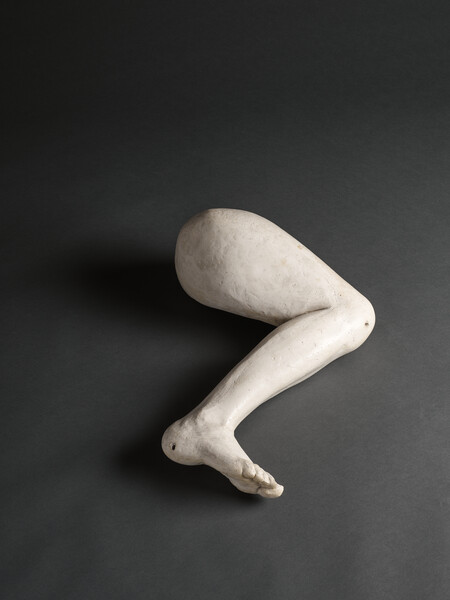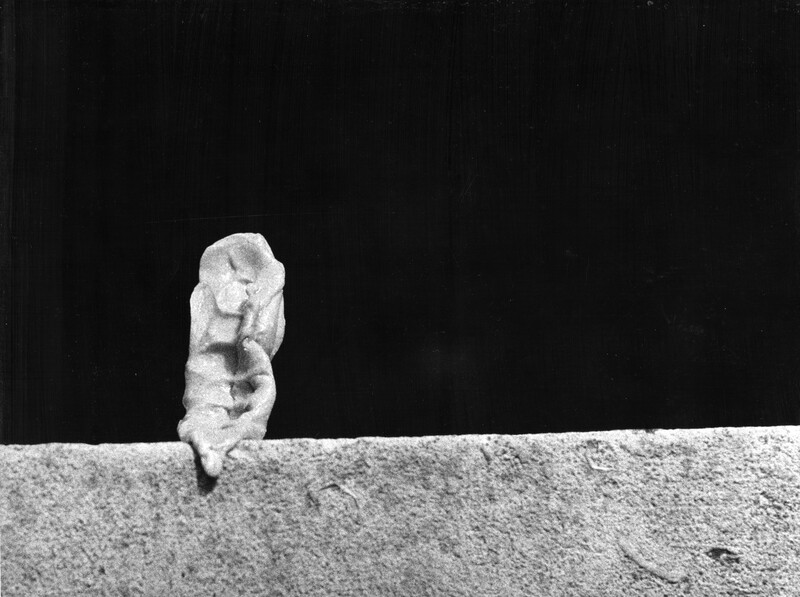Exhibition Guide: Alina Szapocznikow

Alina Szapocznikow with 'Illuminated Woman' (detail), 1966-1967, at her Malakoff studio, Malakoff, France, 1966
Exhibition Guide: Alina Szapocznikow
Following an initial debut at Hauser & Wirth New York in late 2019, ‘To Exalt the Ephemeral: Alina Szapocznikow, 1962 – 1972,’ is the first solo presentation of Alina Szapocznikow’s work in the UK since the artist’s acclaimed exhibition at The Hepworth Wakefield in 2017. Alina Szapocznikow radically re-conceptualised sculpture as a vehicle for exploring, liberating and declaring bodily experience. The exhibition begins in 1962 with Szapocznikow’s first self-cast and ends in 1972 with the artist’s final body of work, the Herbarium series. This selection of works from the artist’s last decade of life surveys the expressive force of Szapocznikow’s material innovation.

Alina Szapocznikow, Noga (Leg), 1962. Photo: Thomas Barratt

Alina Szapocznikow in her Brzozowa Street studio, Warsaw, PL with her work ‘Noga (Leg)’ in 1965
The Fragmented Body 1962 – 1965
In 1962 Alina Szapocznikow created ‘Noga’ by casting her own leg in plaster. It is the first instance of the artist making an imprint of her own body, a process that she would repeat throughout the remainder of her career. Over the next decade Szapoznikow would cast lips, faces, breasts, bellies, legs, and, in the last year of her life, a full body. Szapocznikow’s work poses a challenge to the tropes of traditional sculpture and classical figurative depictions of the human body as a whole and integrated entity. Her use of casting and repetition, evoking assembly-line production, defies hierarchical notions of the sculptural object as a unique form. Szapocznikow’s presentation of the body as fragmented, detached from its origin and reassembled, gives her work an internal tension that teeters on violence. At the same time, Szapoznikow creates her human landscapes with a confident sexuality. Through the allusion of dismembered parts, Szapocznikow presents the body as fetish, simultaneously eroticized and abject. Szapocznikow’s open exploration of the body creates a charged atmosphere for the viewer, who is captured by the contradictory feelings of desire and fear. The works Szapocznikow produced between 1962 and 1972, the last decade of her life, belong to a distinctly modern era and reflect influences from the major twentieth century artistic movements of Futurism, Surrealism, Pop Art, and Nouveau Réalisme.

Alina Szapocznikow, Fotorzeźby (Photosculptures) [detail], 1971/2007

Alina Szapocznikow, Człowiek z instrumentem (Man with Instrument), 1965. Photo: Fabrice Gousset
Abstract Figuration 1965 – 1971
In 1964 Szapocznikow began a new phase in her work by combining casts of the body with metal car parts. The use of the automobile as a stand-in for the human form connects Szapocznikow to early twentieth-century artistic movements such as Futurism and Dada, and to Marcel Duchamp’s use of the readymade. In ‘Man with Instrument’ (1965), a car part is positioned as an extension of the figure. The machinery’s seamless replacement of a body part once again finds the artist exploring issues of corporeal commodification and questioning the perplexing and menacing ways in which technology exerts power over the body. In ‘Photosculptures’ (1971), Szapocznikow, with the help of Roman Cieślewicz, captures twenty pieces of chewing gum in anatomical postures. The artist explained: ‘In shaping with my mouth odd-looking and bizarre forms, I suddenly realized what an extraordinary collection of abstract sculptures was moving between my teeth. One has only to photograph and enlarge my masticated creations in order to achieve a sculptural presence.’ Szapocznikow identified in her dental impressions a highly original method for self-casting. Formally, these unusual little representations recall the abstract figurative sculptures characteristic of the artist’s work during the second half of the 1950s.

Alina Szapocznikow, Lampe-bouche (Illuminated Lips), 1966. Photo: Thomas Barratt
Alina Illuminated 1966 – 1970
By the mid-1960s Szapocznikow was actively experimenting with new materials such as polyester resin. This newly available commercial material dries quickly and has a fragile, fleshlike surface unlike the effects of traditional sculptural materials. Szapocznikow explained: ‘Plastic materials seem perfect to me for attempts to express and capture our age because of their repetitive possibilities, their lightness, their colors, their transparency, their inexpensiveness.’ In 1966 the artist created numerous functional sculptures in polyester resin: glowing female lips extending from elongated stemlike bases, wired as lamps. The utilitarian function of these objects contradicts their natural shape and glowing corporeality. Trapped between household commodities and bodily forms, Szapocznikow’s lamps possess an inherent contradiction. Illumination would become a signature element in Szapocznikow’s oeuvre. She made many versions of the ‘Illuminated Lips’ incorporating the casts of different female friends, including actress Julie Christie.

Alina Szapocznikow, Pamiątka I (Souvenir I), 1971. Photo: Fabrice Gousset

Alina Szapocznikow, Pamiątki (Souvenirs), 1967. Photo: Thomas Barratt. All images: © ADAGP, Paris. Courtesy the Estate of Alina Szapocznikow / Piotr Stanislawski / Galerie Loevenbruck, Paris / Hauser & Wirth
The Souvenir Series 1967 - 1971
In 1967 Szapocznikow began to regularly embed photographic images into semitranslucent layers of polyester resin. In the series titled Souvenirs, a layer of skin-like resin coats images of celebrity figures (among them the mod icon Twiggy), portraits of friends (such as artist Christian Boltanski), and self-portraits. Like the imprint of the body culled from a plaster cast, the photograph retains an explicit relationship to its subject. In this new series, photography takes over the indexical role of the cast; both techniques possess the unique ability to represent presence and loss simultaneously. In the early 1970s Szapocznikow returned to the Souvenir series, integrating childhood snapshots and images of Holocaust victims into her constellation of source materials. ‘Souvenir I’ (1971) includes an image of Alina as a young girl, smiling and sitting atop her father’s shoulders during a visit to the seaside. Around her self-portrait swirls the face of a concentration camp victim, an image that Szapocznikow would use in other works. This object integrates multiple temporalities: a time before, during, and after the war, with the last of these represented by the moment of the work’s creation. Both personal and collective histories are memorialized in this sculpture. The fleshlike surface of the resin casing connects Szapocznikow to a matrix of female artists working around the same time and mostly in New York, such as Eva Hesse, Louise Bourgeois, Lynda Benglis, and Hannah Wilke—women connected by an engagement with unexpected industrial materials, subject to visible age, to evoke the human body and its relationship to time in sculptural form.

Alina Szapocznikow, Herbier bleu I (Blue Herbarium I), 1972. Photo: Fabrice Gousset

Alina Szapocznikow, Tumeur (Tumor), 1970. Photo: Fabrice Gousset
Tumors, Herbarium, and ‘Self-portrait’ 1969 – 1972
In 1969, after having been diagnosed with breast cancer, Szapocznikow began making Tumors. These small, lumpen forms are molded from resin and contain mixtures of crumpled photographs, newspaper, and gauze. Significations of sickness and mortality became characteristic of Szapocznikow’s work beginning in 1968. The Herbarium (1972) are sculptures and reliefs made from flattened casts of the bodies of Szapocznikow and her son, Piotr. One of the artist’s last bodies of work, the Herbarium capture distinct facial features and physical characteristics frozen in time. Szapocznikow’s formerly sensual bodily forms have lost their volume; the polyester resin casts have been pressed like a preserved flower between the pages of a book, giving the impression of frail, flayed skin.
While skin is a layer of protection dividing interior from exterior and self from surroundings, Szapocznikow’s thinned, detached integuments evoke the disintegration of barriers; the body’s layer of armor cannot protect it from the inevitability of death. Two ‘Self-portrait’ works, made in 1971 in plaster and resin, evoke death masks; and indeed, Szapocznikow would die from cancer in the early months of 1973. These final works recall a significant moment in 1954 when Szapocznikow created her first cast of a human body: a death mask of her friend and artist Tadeusz Trepkowski. As Alina described her work at the end: ‘Despite everything, I persist in trying to fix in resin the traces of our body: I am convinced that of all the manifestations of the ephemeral, the human body is the most vulnerable, the only source of all joy, all suffering, and all truth.’
‘To Exalt the Ephemeral: Alina Szapocznikow, 1962-1972’ is on view at Hauser & Wirth London from 7 February – 2 May 2020, following on from the gallery’s first solo exhibition devoted to Szapocznikow at Hauser & Wirth New York, 69th Street in 2019.
Resources
1 / 10









